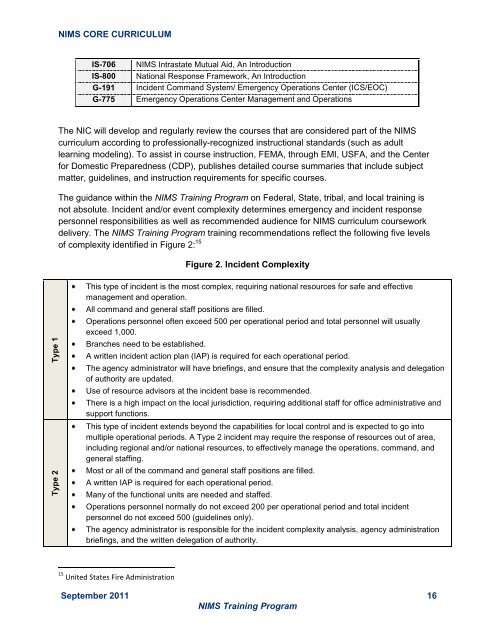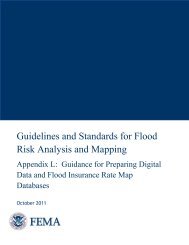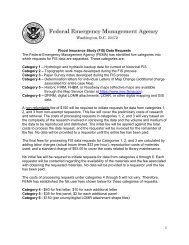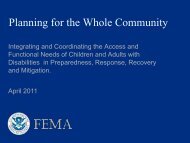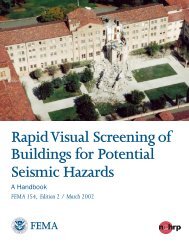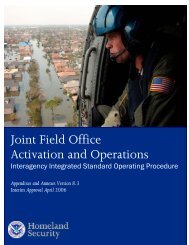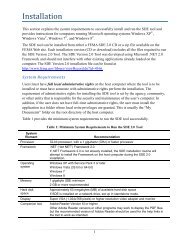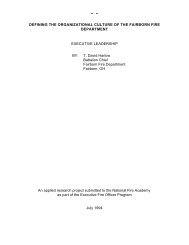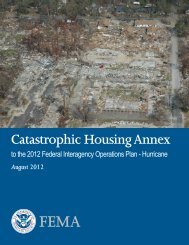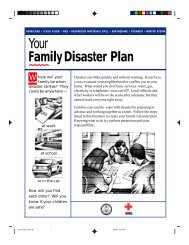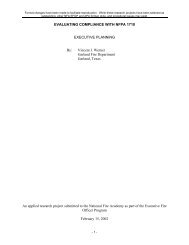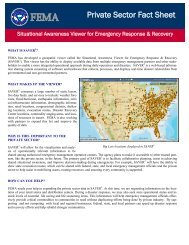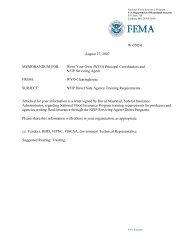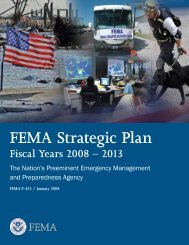NIMS Training Program - Federal Emergency Management Agency
NIMS Training Program - Federal Emergency Management Agency
NIMS Training Program - Federal Emergency Management Agency
You also want an ePaper? Increase the reach of your titles
YUMPU automatically turns print PDFs into web optimized ePapers that Google loves.
Type 1<br />
Type 2<br />
<strong>NIMS</strong> CORE CURRICULUM<br />
IS-706 <strong>NIMS</strong> Intrastate Mutual Aid, An Introduction<br />
IS-800 National Response Framework, An Introduction<br />
G-191 Incident Command System/ <strong>Emergency</strong> Operations Center (ICS/EOC)<br />
Interface<br />
G-775 <strong>Emergency</strong> Operations Center <strong>Management</strong> and Operations<br />
The NIC will develop and regularly review the courses that are considered part of the <strong>NIMS</strong><br />
curriculum according to professionally-recognized instructional standards (such as adult<br />
learning modeling). To assist in course instruction, FEMA, through EMI, USFA, and the Center<br />
for Domestic Preparedness (CDP), publishes detailed course summaries that include subject<br />
matter, guidelines, and instruction requirements for specific courses.<br />
The guidance within the <strong>NIMS</strong> <strong>Training</strong> <strong>Program</strong> on <strong>Federal</strong>, State, tribal, and local training is<br />
not absolute. Incident and/or event complexity determines emergency and incident response<br />
personnel responsibilities as well as recommended audience for <strong>NIMS</strong> curriculum coursework<br />
delivery. The <strong>NIMS</strong> <strong>Training</strong> <strong>Program</strong> training recommendations reflect the following five levels<br />
of complexity identified in Figure 2: 15<br />
Figure 2. Incident Complexity<br />
This type of incident is the most complex, requiring national resources for safe and effective<br />
management and operation.<br />
All command and general staff positions are filled.<br />
Operations personnel often exceed 500 per operational period and total personnel will usually<br />
exceed 1,000.<br />
Branches need to be established.<br />
A written incident action plan (IAP) is required for each operational period.<br />
The agency administrator will have briefings, and ensure that the complexity analysis and delegation<br />
of authority are updated.<br />
Use of resource advisors at the incident base is recommended.<br />
There is a high impact on the local jurisdiction, requiring additional staff for office administrative and<br />
support functions.<br />
This type of incident extends beyond the capabilities for local control and is expected to go into<br />
multiple operational periods. A Type 2 incident may require the response of resources out of area,<br />
including regional and/or national resources, to effectively manage the operations, command, and<br />
general staffing.<br />
Most or all of the command and general staff positions are filled.<br />
A written IAP is required for each operational period.<br />
Many of the functional units are needed and staffed.<br />
Operations personnel normally do not exceed 200 per operational period and total incident<br />
personnel do not exceed 500 (guidelines only).<br />
The agency administrator is responsible for the incident complexity analysis, agency administration<br />
briefings, and the written delegation of authority.<br />
15 United States Fire Administration<br />
September 2011 16<br />
<strong>NIMS</strong> <strong>Training</strong> <strong>Program</strong>


